Why government decision-makers can’t ignore the public’s trust
KEY FINDINGS:
- Over the past 50 years, Americans have lost trust in the government
- Trust in federal agencies varies
- Some agencies are more polarizing than others
- Even as many trust the CDC, pandemic polarization still shows
- Messenger cueing has affected the public’s trust in CDC during the pandemic
Federal agencies keep America running. Whether researching and communicating about public health, serving Veterans, or ensuring the transportation infrastructure underpinning our economy is working, their jobs have great significance.
As officials fight generationally high inflation and support America’s post-pandemic recovery, the way they address these issues, and the public’s perceptions of those actions, can affect the federal government’s response to the next crisis.
Trust is a key marker for agencies’ legitimacy with the public, and it is essential for these institutions to achieve success. Without the public’s trust, agencies face an uphill battle when it comes to fulfilling their missions.
Policymakers and government officials need to understand this. New Ipsos research illuminates how Americans view key agencies and uses the CDC’s experience during COVID to explore how a crisis can undermine public trust.
1. Over the past 50 years, Americans have lost trust in the government
It’s critical for decision-makers to understand that declining trust in government hasn’t just been a byproduct of a tumultuous few years—it’s been building up over the past few decades.
For at least 50 years, control of the executive branch and congress has shifted, but regardless of who’s in charge, the public has been steadily losing trust in the government. This suggests that this low level of confidence in government institutions isn’t a one-off trend—it’s here to stay. Since federal agencies are part of the government and communicate and implement policy from that vantage point, it is essential that these agencies take note of the historic trend here.
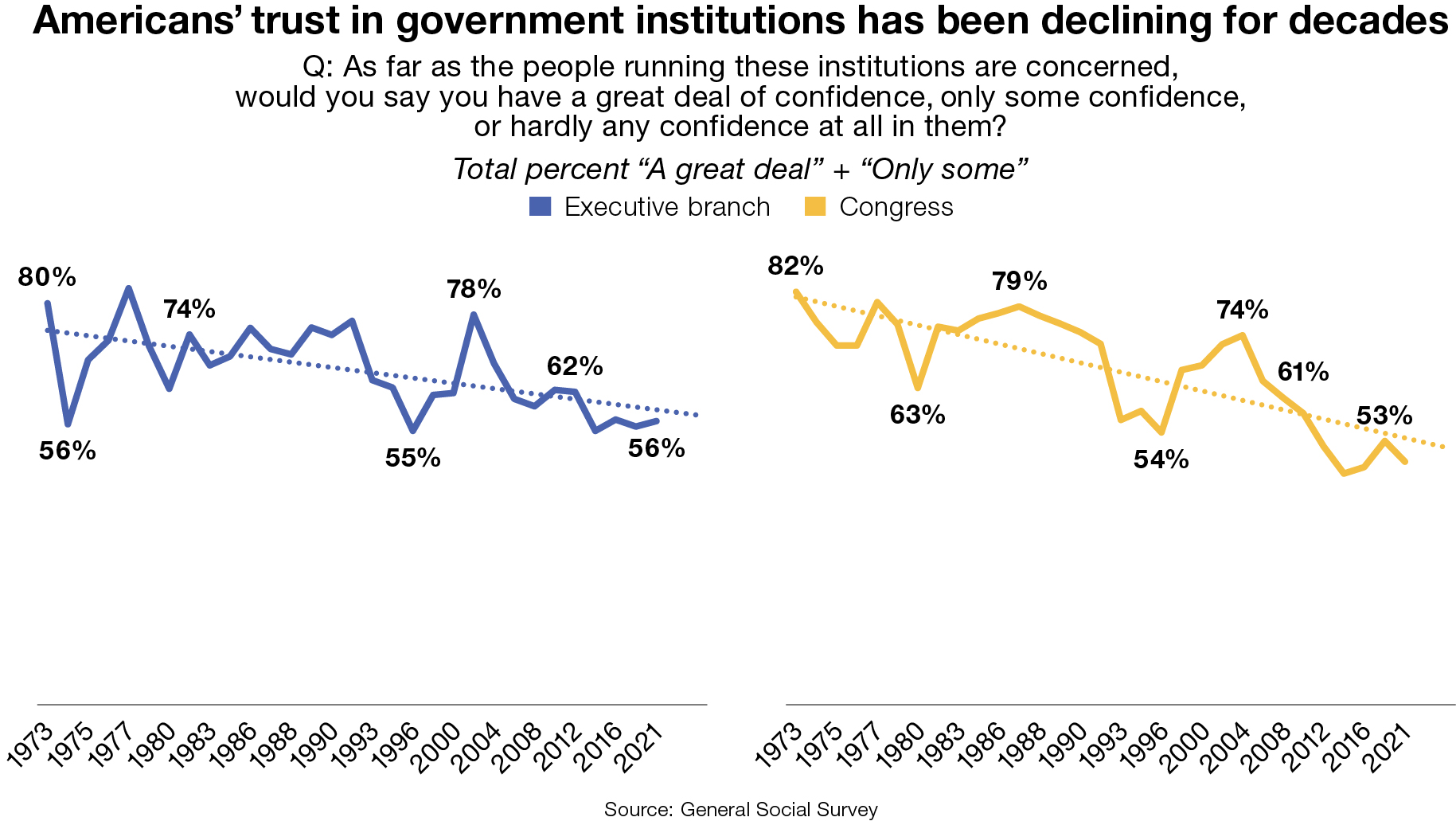
2. Trust in federal agencies varies
Decision-makers in government should understand that while trust in government is low, trust in specific federal agencies varies. In an Ipsos poll that tested the public’s trust of five federal agencies prominent in the news cycle, the Food and Drug Administration (FDA) and the Centers for Disease Control (CDC) ranked as the most trusted—about three in five Americans trust information, news, or guidance from the FDA and CDC.
Fewer Americans are confident in the information and guidance they receive from the Department of Veterans Affairs (VA) and the Federal Reserve, though they are still trusted by around half of Americans.
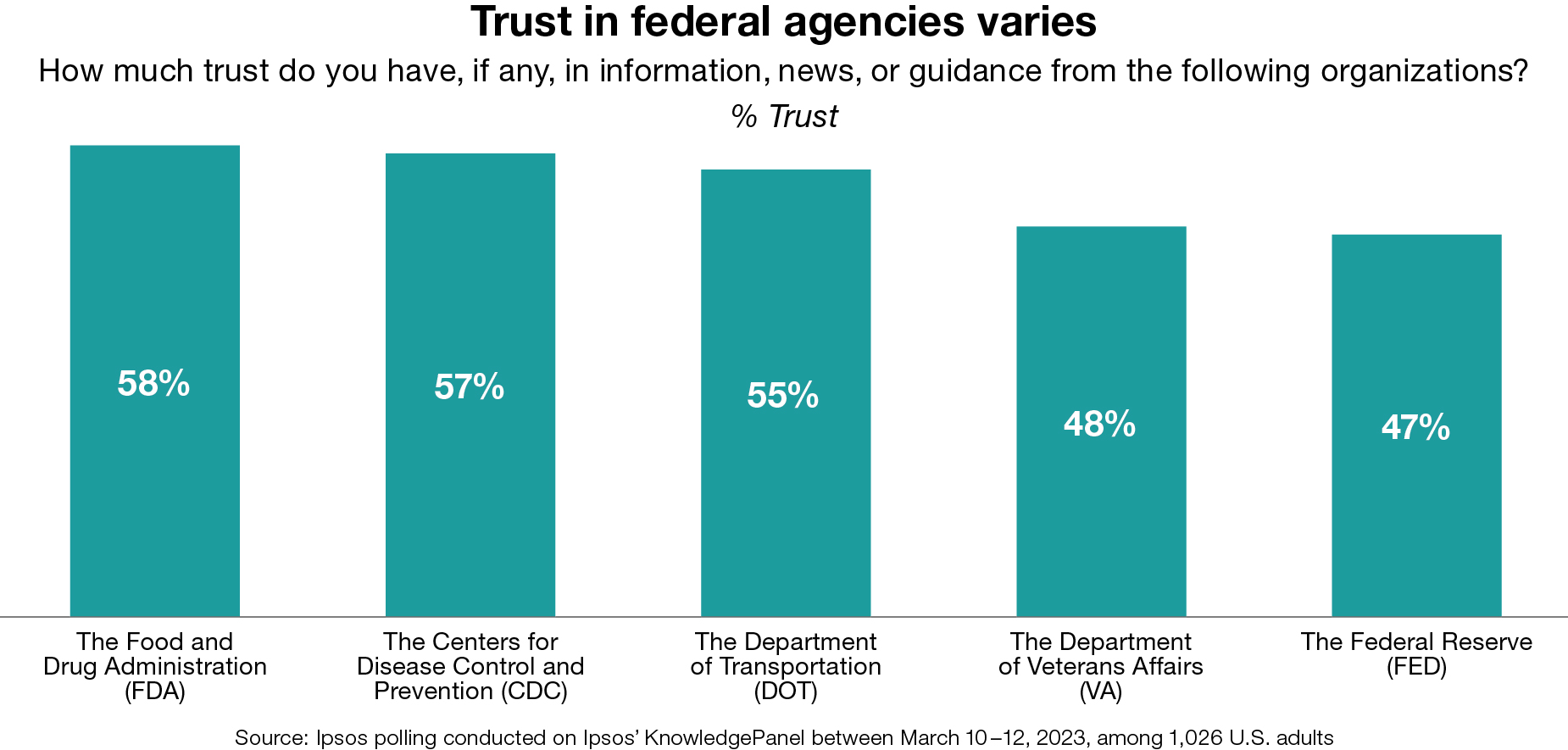
3. Some agencies are more polarizing than others
When breaking down the fault lines in the public’s trust, it’s important for policymakers and legislators to recognize that political polarization drives whether an American views an agency favorably—or unfavorably. Among the agencies tested, the Department of Veterans Affairs is the only agency largely viewed as objective and serving the public by majorities of Americans, regardless of political party.
Disagreeing on the validity of federal agencies is more the norm. The CDC exemplifies this more than its peers—it is one of the most polarizing agencies. There is a roughly 50-point difference between Democrats and Republicans on whether the agency is guided by facts and science and works for the best interest of the public. Nearly all Democrats feel the CDC does this well, while fewer than half of Republicans agree.
In fact, most Republicans do not believe federal agencies operate apolitically and feel that each federal agency tested does the bidding of partisan political figures. At the same time, Democrats are more likely than Republicans to believe that these agencies are guided by facts and science, work in the best interest of the public, and provides an important public service.
Still, that doesn’t mean trust from Democrats is guaranteed. About two in five Democrats believe these agencies do the bidding of partisan political figures, suggesting that, should the presidency flip and new political appointees arrive, trust among Democrats could soften.
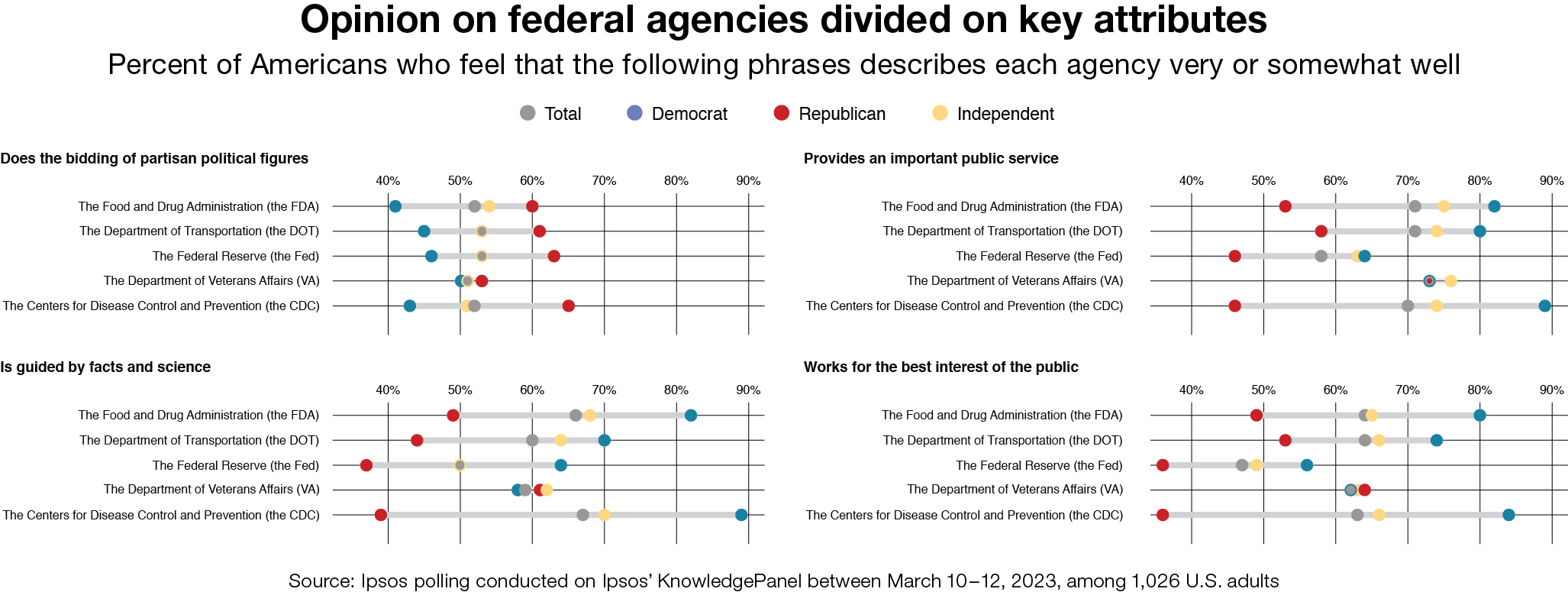
4. Even as many trust the CDC, pandemic polarization still shows
Decision-makers should consider how public communication from federal agencies may be absorbed into the culture wars. Where the CDC stands with the public, coming out of the pandemic, offers an illustrative example.
At the start of the pandemic in the U.S., in March 2020, practically all Americans (87%) trusted the CDC to provide them with accurate information on COVID-19, according to the Axios/Ipsos Coronavirus Index. By December 2022, nearly three years later, only 63% of Americans trusted information about COVID from the CDC.
The gap between Democrats and Republicans is driving the declining trust in the CDC. Many of the pandemic guidelines introduced by the CDC to slow the spread of the pandemic, such as mask use, social distancing, and vaccine adherence, became markers of politics—a way of showing what political team someone supported. The hyperpartisan dynamic of America’s political system infects any public discourse or conversation, making gaining and maintaining trust with wide segments of the public a particularly fraught exercise. Understanding where these cultural and political fault lines exist is essential to navigating trust with the public.
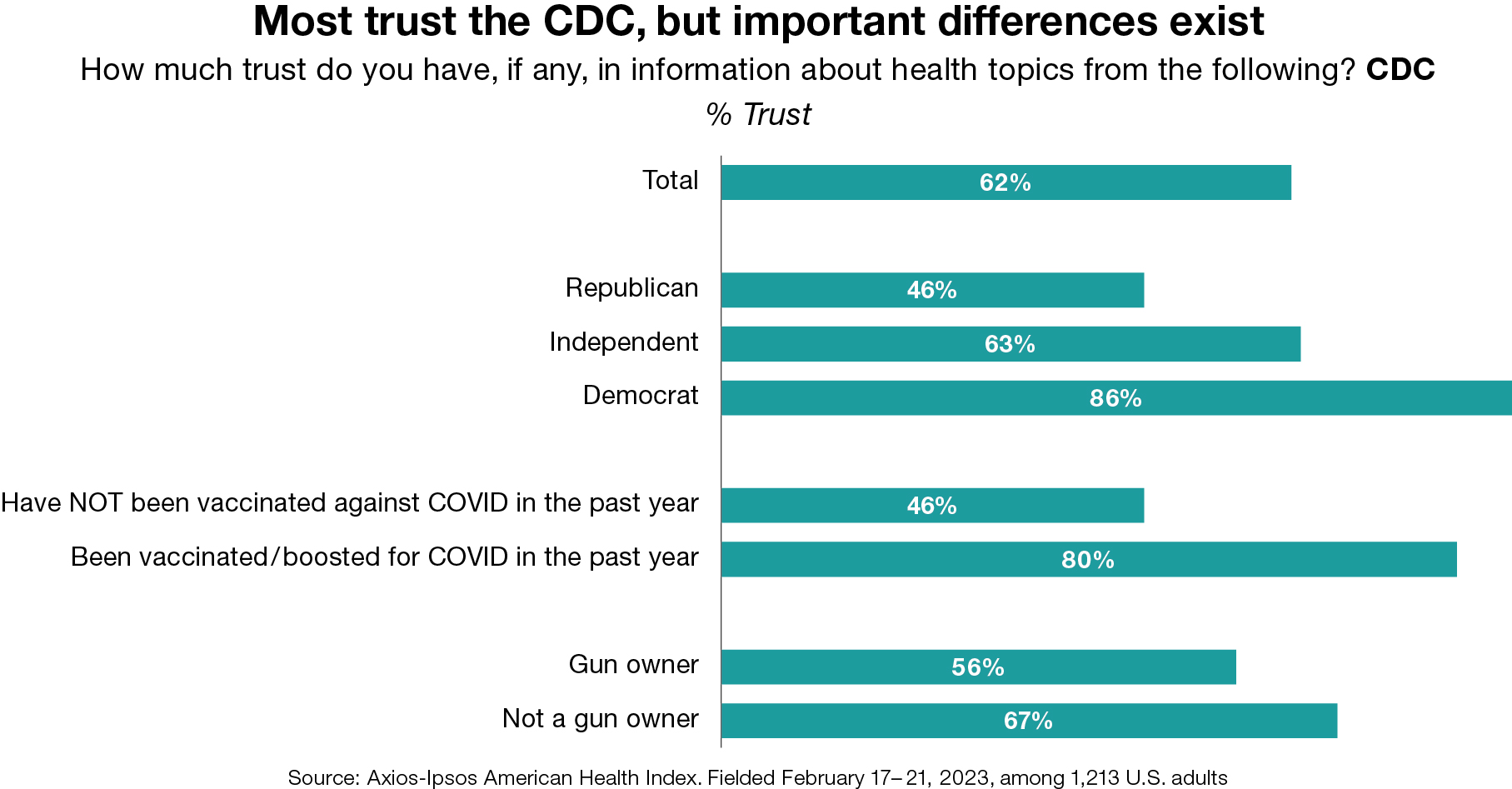
5. Messenger cueing has affected the public’s trust in CDC during the pandemic
One way public communications get politicized and absorbed into the culture wars is through cueing from political elites. Attitudes toward the CDC during the pandemic changed dramatically based on what news source people were tuning into.
In March 2020, at the start of the pandemic, decisive majorities of Americans trusted information from the CDC, regardless of their primary news source. But as the tone of news coverage around the CDC from major conservative outlets turned negative, the presidency changed hands from a Republican to a Democrat, and the COVID vaccine campaign got underway, trust in the CDC fell precipitously among viewers of these conservative outlets; it dropped 55 points among Fox News viewers between the early days of the pandemic and December 2022. At the same time, confidence in the CDC among CNN and MSNBC viewers remained almost unanimously positive throughout the pandemic. While a striking example, this demonstrates how divergent opinion can become when brought into the political polarization cycle. Executives and leaders at federal agencies should be aware of the dynamics at play here.
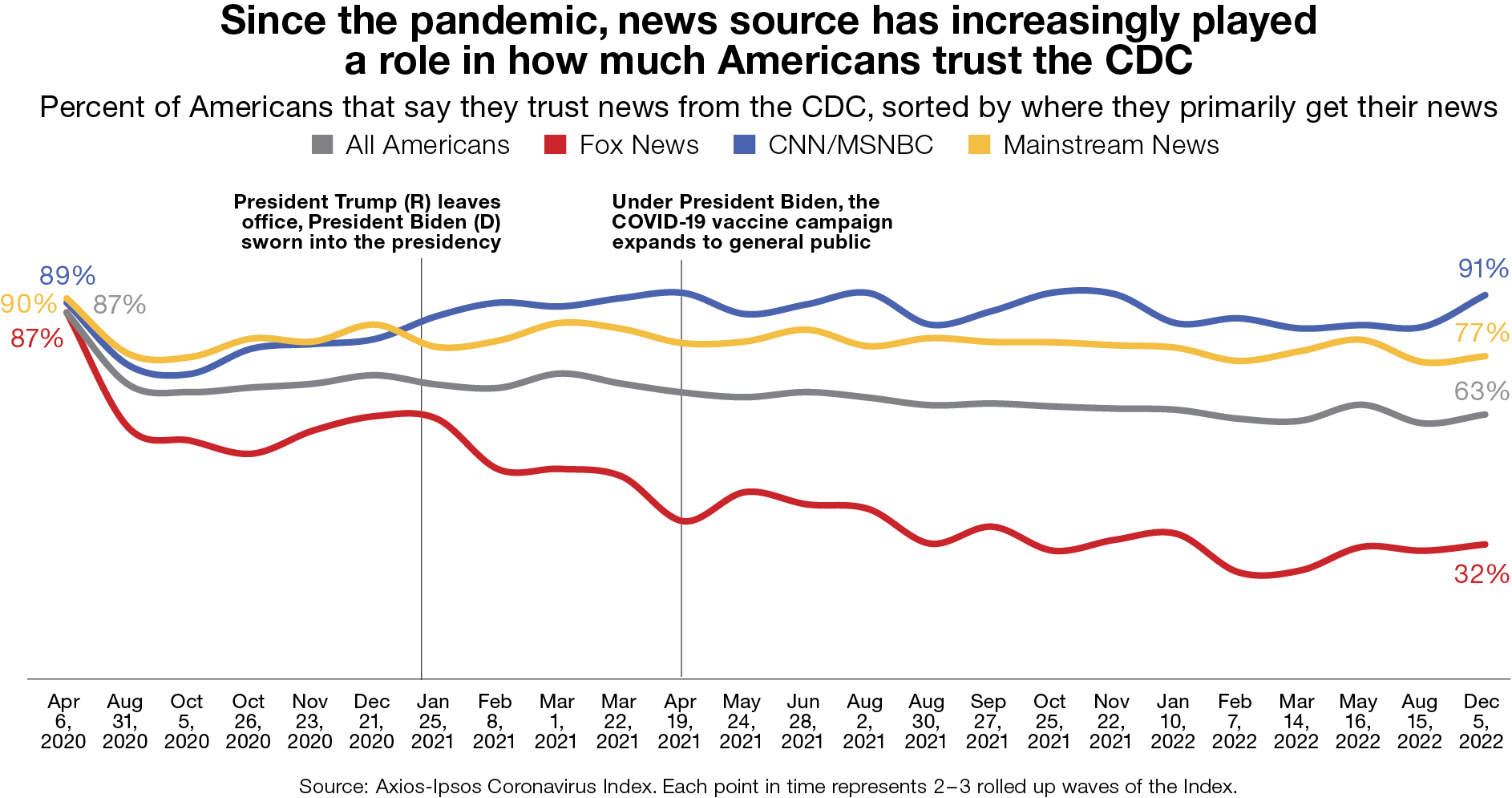
Trust in federal agencies is a complicated and nuanced topic with critical implications for the success of federal agencies and their missions. Here are four things to keep in mind:
WHAT’S NEXT:
- Americans have been losing trust in government for fifty years. Understand the historic context federal agencies operate in.
- Recognize how important trust from the public is for successfully achieving the missions of federal agencies.
- When political polarization touches an issue, some groups may be more difficult to access. Learn and research which communities may be harder to reach.
- Who is speaking and the signals they send matter. Consider political polarization and the impact it has when communicating with the public.


![[WEBINAR] Understanding GEO: How to Get Recommended and Reach Shoppers on AI](/sites/default/files/styles/list_item_image/public/ct/event/2025-11/thumbnail-templates.png?itok=KvQQfkES)
